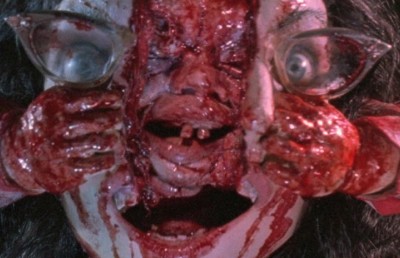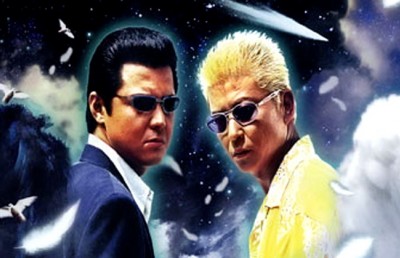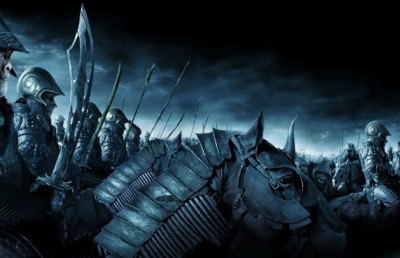Fantasia 2001 Report: Take 2
Asian Invasion 2

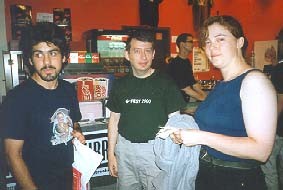
Fantasia Loyalists inside mecca Imperial
I will forego my usual well-ordered, theme-driven approach to festival reporting, for an elliptical puttying up of festival crevices uncovered in Randolph Jordan’s excellent, in-depth round-up of Fantasia Year 6. In some cases I am driven to write at length, while in other cases in short, scattered probes. I begin with a film from the nation which had the best percentage track record at this year’s Fantasia, Korea. Every Korean film at Fantasia this year had something of value and merit. Six films, no duds: Barking Dogs Never Bite, The Foul King, The Isle, Joint Security Area: J.S.A., Tell Me Something, and Die Bad. The films collectively demonstrate how recent Korean cinema continues to produce films which achieve the unique quality of keeping both public and critics happy, in other words, the enviable combination of entertainment invested with strong social undercurrent (to name just a few other recent cases, Whispering Corridors (Park Ki-Hyung, 1998), Attack the Gas Station (Kim Sang-Jin, 1999), Shiri (Kang Jeg-Yu, 1998), and Spring in My Hometown (Lee Kwang-Mo, 1998), and Barking Dogs Never Bite (Bong Joon-Hu, 2000). The Korean film I have chosen to wrote at length on is in fact the first film I saw at the festival this year, Die Bad. Unfortunately, the 35mm print was in limbo somewhere in transit from another festival (Brazil if I remember correctly from my brief post-movie chat with Pierre Corbeil), so Fantasia had to make by with a video screening. The visual flair of this first time film by Ryu Seung-wan understandably suffered from the medium slum downing, but could not mask its young energy and enthusiasm. The film is structured as a four part story charting a ‘crime does not pay’ message. In the first, “Rumble”, two 19 year old friends get into a gang scrap in a billiard hall, leading to the death of one teen: filmed in slo-mo, the teen is hit on the side of the head with a bottle, causing him to hit his head against the steel corner of a pool table, on his backward fall to the floor. Blood quietly forms a pool under his fallen body. The representation of physical violence is stylish yet emotionally painful. The film then progress like William Wellman’s early gangster classic Public Enemy (1931), as one of the men from this group, Suk-hwan, becomes a detective, while the man who flung the fatal blow, Sung-bin, is roadblocked into a life of crime. </p
“Nightmare” is the second episode. Sung-bin comes out of jail after 7 years, and finds he is hindered from the straight and narrow by a society that harbors prejudices, right from a detective who warns him not to “fuck up his district,” to his dysfunctional family. The latter is played in one great scene around a dinner table, where the old-school father laces into his just-released son, inciting the daughter to turn on the insensitive father, the brother to in turn slap her, which then causes everyone at the table to start crying. Sung-bin is not your remorseless murderer, just someone who made a mistake, a big one which will haunt him forever. Which is why he sees nightmarish ghost images of the dead man stalking him.
What marks this as a first-time film is a style that goes all over the place, without a sense of a guiding vision (which in part accounts for its energy and verve). From documentary (static camera, direct camera address), to hip music video editing, to visceral, hand-held, ‘reality TV.’ Sung-bin has clearly seen his adolescent gang films, with the staging of his rumble/fight scenes reminiscent of Rumblefish and A Clockwork Orange. However, Sung-bin interjects a clever discourse into his representation of violence. The opening death scene is brutal, but no one seems to get hurt in the violence after this opening death, until, that is, the ending, where crime is de-glorified by a protracted display of brute violence. Sung-bin works his way up the corporate gangsterism ladder, and initiates Suk-hwan’s younger brother into a life of crime. The film ends by coming around full circle back to same pool hall, with the same two characters fighting, as Suk-hwan tries to get Sung-bin to tell him where he sent his younger brother, a high school dropout lured into gangsterhood. “To hell” is right. The young crime novices are send as decoy, ‘knife fodder’ to delay an older group of gangster henchmen. The denouement is extremely violent, as the film crosscuts between the two ex-friends settling old scores in the pool room and the large scale slaughter of young, naive gangster wannabes at the hands of hardened blood-thirsty professionals. Sung-bin pushes his thumbs into Suk-hwan’s eyes, blinding him; while Suk-hwan’s brother is repeatedly stabbed to death. The painless violence which cruised aimlessly from the end of the opening onward now becomes real and painful. The latter aided by the decision to film the last segment in black & white, which renders a more realistic and emotionally visceral edge to the violence and ‘crime does not pay’ message.
The main stylistic device, if there is one, is cross-cutting, which gives the ending its structural power. For example, in an earlier scene we crosscut between a detective and crime lord giving direct camera address explanations of their respective career paths (their motivations, aspirations, etc.), and a marathon bout between them that makes the fight in Quiet Man between John Wayne and Victor McLaglen seem like round one of a ten rounder.
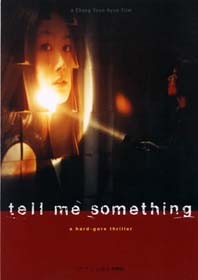
The Korean Tell Me Something by Yoon-Hyun Chang is a good although ultimately conventional serial killer/cop thriller which stars huge mega-star Han Suk-gyu and Shim Eun-ha, who struck on-screen chemistry in the quietly understated tear-jerker Christmas in August. The film leaves a lot of loose ends, narratively and visually, which makes me anxious to revisit the film to see whether this is merely an intended effect, or just a residue of poorly plotting (or the apparent re-editing that I learned of through a piece in a recent Fangoria issue). By the end, we are still not sure who the killer was, or how many there are. Three men, all of whom were involved romantically with a quiet young beauty (Shim Eun-ha), are murdered and their body parts switched around. The suspects include the young woman’s next-in-line admirer, her own father, a controversial famous artist, her girlfriend, who it ends up is actually a boy in love with her who nearly died in a fire years earlier, and the woman herself. The film looks and sounds good, trading off those warm Se7en tones with a cooler overall aesthetic design.
St. John’s Wort (2001, Japan, Shimoyama Ten) holds considerably more visual interest than narrative or thematic. The latter in fact is only a pretext for the computer game pacing and structure. The film begins with some young, hip game programmers brainstorming for their newest game. The cinematography is off the map, with candy-colored bright yellows and pastels, matched only by a young programmer’s bright yellow hair. A new employee, Nami, comes into the gaming studio, and soon leaves with one of the programmers, a former boyfriend, to enter the house where she grew up with her famous painter father. The journey to the macabre house is one of the highlights, with the surrounding natural landscape around the house a brilliant visual cacophony of surreal proportion. The landscape looks as if it came out of an inkjet printer with the color tones all mixed (grass is purple). The two young protagonists move from room to room, searching for clues and entrance points as if in a computer game. Coming across Nami’s father’s Bacon-esque paintings of tortured souls. We of course find out that their actions in the house, searching for and then meeting the ghost painter, and Nami’s long lost sister (or brother?) Naomi, are all, indeed, part of the game. The shots with the painter recall Pupi Avati’s classic giallo The House With the Windows that Laugh, and the use of his tortured, expressionist photos the giallo film in general. But not much is done thematically with the art, other than the conclusion, where we discover that Nami’s sister/brother has a suicidal plan that involves Nami to complete the father’s unfinished masterpiece. The unfinished painting is of a woman with her eyes bleeding standing amidst burning flames. For the sake of art, the psychotic sibling forces Nami, whom she feels has some of her father’s genius, to complete the masterpiece. She gouges her own eyes, sets a fire around her, and then stands posed as the model. It ends with the scene cutting to outside the burning mansion, a la Inferno, then back to the programmers at their computers. It is now conclusively revealed that we have been watching a film within a film structure (or game within a film structure). They all agree that the ending as it stands is too much of a downer. Nami proposes an alternative ending, one which has her and the young man escaping the fire, only to end with a Carrie-like moment of the father sprouting up from the ground to grab them. They are all impressed at Nami’s twist ending, only Nami ends the film on the pregnant revelation that the final twist ending was not of her doing: “That wasn’t me!”
Ripper: Letters From Hell (2001, John Eyres) is a bad slasher film that belongs in a time warp from the 1980’s. The film has more character development than usual, but awful dialogue that continually repeats anything, joke or plot point, that is not as plain as the whites in your eye, to make sure everybody in the audience gets the point. The film’s style is extremely abrasive, loud, jolting and without any sense of aesthetic balance. It begins with the young female lead, Molly (A.J. Cook, who is very good in her role), surviving a serial attack that kills a boat load of her friends. Five years later she exorcises her past by taking a University course with famed FBI profiler Martin Kane (a reference to William Peter Blatty’s novel Twinkle, Twinkle Killer Kane?). She plays the rebel loner outsider who slowly warms up to her preppy classmates, until killings patterned after Jack (the Ripper, not Nicholson) begin around her. When her classmates find out that she hid her past first hand-encounter with death, they lash out at her. The film is giallo-like in that there is more emphasis on the who dunnit, and there are enough red herrings to satisfy any fish lover. Is it the teacher? Is it that strange student who doesn’t fit in? Is it the creepy detective who shows up unexpectedly (Jurgen Prochnow)? Is it the guy with amorous designs on Molly? Does anyone care? The possible identity of the killer goes on back and forth right up until the end, when the killer is finally revealed as the detective. It ends with a real hoary epilogue, with Molly now ‘recovered’ and sporting jet black hair, dressed in late 19th garb, walking out of a building into the 19th (back to the good old days of Jack the Ripper, where she can really exorcise herself, get it!). The film comes very close to being pure camp fun (a la Fatal Frames, a real barn-burning, unintentionally hilarious giallo from a few years back), especially in the ‘romantic’ scene where Molly gives in to the older teacher’s amorous designs. But unfortunately the film irritates with Eyres insistent dependence on his limited bag of cinematic horror tricks: the startle effect (which he uses at least 15 times), and, for atmosphere, lots and lots of thunder and rain (Eyres must have thought he was in London).
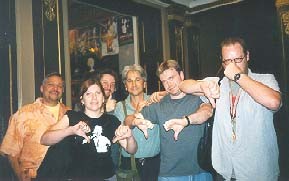
Fantasia Media Horde Give (Almost) Unanimous Verdict On Ripper: Letter From Hell
Two films which can be best referred to as tangential Fantasia material were Ghost World (2001, Terry Swigoff) and Denti (2000, Gabriele Salvatore). The former is an excellent, stylish, engaging and funny existential teen drama. Performances all around were excellent, especially Betty-like Enid by Thora Birch and the girl with the Tullulah Bankhead raspy, sexy voice, Rebecca (Scarlett Johansson). Casting the 40 plus Buscemi as the obsessive, loser record collector was an important balance to their young precociousness. The costumes, comic book color saturation, and emphatic camera movements gives the film a mature, almost somber style that offsets the apparent lightness of the material and which underscores the darker core at the heart of the film (search for meaning in young life, sense of social alienation, sense of cultural death, cultural stagnation). On the latter point it is interesting to note that the film begins with, and often returns to, a Hindu pop song-video we see intercut with a lateral tracking shot by a working class tenement windows. One of the people seen is Enid dancing to the music, while the other people appear lifeless, stuck in a rut. When Enid asks Seymour at his Saturday garage sale whether he has this particular song, he replies, “I don’t collect anything foreign.” Which seems to me to be a sly comment/critique on US cultural parochialism. And within that, hierarchies predicated on ‘pure’ versus adulterated music forms (country blues, Mississippi blues, ragtime, etc.). At first they use Seymour as victim of their cruel humor, setting up a false blind date for him and then being there to watch his pathetic figure in waiting. But then Enid becomes attracted to Seymour, no doubt because she too shares his sense of social alienation, of never fitting in with anyone. To the point where she becomes jealous and motherly of the woman she helped find for him. Which is brought out in a funny scene where Seymour is on a date and receives a call from Enid asking how the date is going. When he hangs up the date asks who it was and he replies, “My Mother.” Swigoff cuts to a shot of Enid lying on her bed, phone in hand. Enid is exquisite in every sense. Swigoff makes her clumsy and somewhat overweight (only by Hollywood’s pencil-thin standards, and less conventionally beautiful than Rebecca), yet her mannerisms, veering on self-parody makeup, and sensual dresses (reds, blues dominate) easily draw us to her. For example, in the scene where she first wears a scarlet red dress, her face is painted in sheer white makeup to create a startling contrast that makes her glare out of the frame.
The film contains some hilarious scenes at the Kwik mart (like something out of the Simpsons, with a Greek owner replacing the South Asian). A moronic white trash musclehead supplies comic relief with his encounters at the Kwik Mart. In one scene as he is being kicked out of the store he insults the owner’s English diction, who replies that it was the Greeks invented civilization. He shouts back, “they also invented homosexuality.” Two funny shots stand-out at the Kwik Mart. The clerk drops a little girl’s ice cream when he sees Enid in the store with the homely Seymour. Cut to a shot of Enid and Seymour, with the little girl crying in the background, and off-screen the voice of the owner yelling, “clean up the fucking ice cream.” The second shot is the pull back during Enid and Seymour’s sexual encounter that reveals one of those rocking horses. Another funny scene is the record collector’s party, to which Enid brings Rebecca along. The two teens stick out like two cats in a pound. One of the men asks Seymour’s roommate, “Who are the cheerleaders?” He replies, “They’re Seymours.”
The sense of magic that ultimately makes this Fantasia material comes at the end, when the film literalizes the proverbial adage, “everyone’s bus will come.” The old man who we have seen intermittently waiting for a bus that is long out of service is proven right when his magic bus surprisingly arrives. Inspired, Enid sits on the bench and ultimately ends up riding off into an unknown future on her own magic bus. While Seymour, ‘outed’ as Enid’s ‘hero,’ is back to square one, or worse yet, at the psychiatrists (with his mother waiting outside, asking him what he wants for dinner). Is she escaping the town’s dead culture? Or is she doomed to repeat her outsider status elsewhere? The film looses some steam when the two girls stray from each other, because we no longer see the world through their acerbic eyes and no longer are treated to their cruel humor. But we always remain interested, even after Enid rides off in her bus and the film fades out.
Of far lesser stature, but an entertaining male fantasy nonetheless, is Denti. The man as a young boy walks through the ruins of Pompeii (the ruins of his life is more like it). While his parents argue, he smashes his buck teeth against a rock, hoping to get rid of them forever. His mother comforts him. But his teeth are irreplaceable. As the Bergsonian voice-over in the beginning states, not everything we remember, not everything we are, resides in the brain or body. In fact, as he becomes a man he realizes that his two front teeth are memory encoded. They become like Proust’s ‘madeleine’s,’ triggering unsuspected memories at the touch of them. Almost always, his beautiful French mother is in them. Only when he comes to terms with his mother’s death, and his desire for her, does his new (third) set of teeth sprout and his life begins anew. the film is pure Fellini-esque in the way he imagines dead people around him, the way his mother materializes in shots, the way he ‘walks’ into his childhood as a man, etc. The women all have the same function: motherhood (his own mother, his divorced wife, the gorgeous young wife of the deaf mute dentist who allows him to smother himself in her breasts). At least Fellini added a whore into the equation. No whores or overweight mothers here, only beautiful young mothers, caught in their prime, and either killed or left alone to raise their children. He suspects his girlfriend’s dentist Luca as her lover. So he goes to another dentist, and another, and another, each weirder than the previous (one who merely takes moulds of teeth, one who works out of a dank catacomb-like room, with his kitchen a throw away from the ‘chair’, a deaf-mute who slaughters his gorgeous unfaithful young wife). Although the Fantasia crowd really seemed to enjoy this one, in the end it ultimately felt to me like second class Fellini. Young boys smothering themselves in big-breasted women, Oedipal charms, walking through one’s visions and imaginations, vivid eccentric characters, Fellini did all of this thirty and forty years ago.
Two of the better films at Fantasia this year were Chasing Sleep (2001, Michael Walker) and Dead Creatures (2001, Andrew Parkinson). And it was a crying shame to later learn during the Q + A session that it will be going straight to video. In the paranoiac tradition of Kafka (Welles’ The Trial comes immediately to mind), Polanski’s The Tenant and Repulsion, we watch a man who may or may not have killed his wife slowly slip into a psychotic quagmire. The film begins like The Trial. He wakes up, engages a phone conversation with a detective, and is visited by detectives who show up at his house and, for the rest of the film, “squeeze” him into a corner of guilt and innuendo. It begins with a CU of a hole and ends on a similar type of hole, this one on the ceiling of their conservatory, with a small ball of light always visible in the space. The film concludes with a nice tracking shot into the conservatory. We see, for the first time, his wife Eve playing the piano. Is she alive? Is this a flashback? Or are we merely in Ed Saxon’s head? The camera dollies toward her, over her, craning up to the hole in the ceiling, and then zooms into the hole. John Carpenter once said that a slow dolly movement, when properly executed, renders the feel of human solidity. Saxon spends most of the film alone in his thoughts, but throughout, the film uses slow dolly movements along dark corridors and hallways that create this ‘sense of a presence.’ This ‘presence’ is actually an absence, his wife, whose lingers as a thought in Saxon’s mind. As he descends into a pool of paranoia the house’s plumbing turns nightmarish (why is it that plumbing is so easy to make nightmarish?). His basement is water-filled. Burst pipes behind walls cause moisture in the walls. All the male people who come to visit him (a doctor, the police) take pills (as he does). Are they all alter egos? He stares into a bedroom window next door while a couple has sex and argues, sometimes simultaneously. Even the sex sounds are off-kilter, the woman’s groans are guttural, animal-like rather than human. But later we see that it is his own self in that room. Is he then just watching his own past life play out? And how about that accusing finger that curls up as it skitters away? Or that hideous man-baby he finds in his tub (a self-image, or the child they never had?). Even the scenes of the eager student who visits him seems like fantasy (they make love right after he hears the couple next door). Or is it his projection of their early years together. Chasing Sleep is a wonderfully edgy psycho-horror film that plays like a modern day Kammerspiel piece.
In Dead Creatures director Andrew Parkinson brings a low-key, ‘slackers,’ or more appropriately, working class sensibility to the zombie film. Some time in the distant future, an zombie epidemic seems to have spread across London, dividing the city into the hunters and the hunted. The zombies, however, are not your typical growling, slumbering, decomposing (though that they become) human-eaters, but a group of marginalised women living together from shanty apartment to apartment trying to lay low and live the final months of their pre-decomposition life in quiet dignity. Unable to blend into normal society, they take odd jobs to pay whatever bills they have, and cling to their pre-zombie past by odd excursions to bars to satiate their sex drive, or visits with not-yet estranged family members. Killing is not treated as a pleasurable activity, but a necessity, not unlike going out to shop for food at the grocery. Usually in groups of two, the women stalk their prey, bring them home, kill and lay the body out for dinner, then store whatever remains there are in the fridge. Seeing them flay the body on the living room table in front of the television and casually yanking body parts gives a whole new meaning to TV dinners. Tracking the zombies down is a Van Helsing-like zombie-killer who serves as his sole judge and executioner. He kills them by strapping them in a chair, interrogating them for any clues that may lead to the whereabouts of his daughter, and then taking a metallic blow-gun to the back of their head (cattle-like). Ostensibly the film’s ‘hero,’ his taciturn, emotionless demeanor and single-minded obsession casts him as an equally tortured soul, and not one the audience can be expected to empathize with. There is no question this is one grim puppy of a film, a sort of kitchen sink realism meets Hammer. One of those rare horror films, like Nosferatu (1922 and 1979), Martin, Combat Shock [aka American Nightmare], The Last House on the Left, Deathdream, and The Addiction, which manages to be equal parts horror and social issue film. Very impressive.
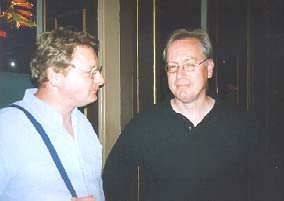
Cinematographer (left) and director Andrew Parkinson of Dead Creatures
I will conclude with two films which demonstrate the always impressive eclecticism of Fantasia. In S & M ‘Ring‘master Hideo Nakata goes back to his roots as an assistant director to Roman Porno director Masaru Konuma, with a loving docu-portrait of said Konuma, one of that genre’s lesser know masters. Nakata’s approach is fairly straight forward in style, with interviews with Masaru Konuma, actresses, and other co-workers, plus film clips with some personal interjections interspersed. We see Hideo as interviewer in the film, and see him as his younger self in set photos from the original films. One actress when asked to describe Konuma him referred to him as a “turtle” (meaning it metaphorically but also physically, somehow crusty on the outside, soft in the inside, etc.). The cut to him seated in a crunched position makes the allusion funny. As do other similar funny juxtapositions, like the cut from a clip shown from Wife to be Sacrificed where the woman (played by Naomi Tani) is forced to defecate in front of her sadistic husband, to a documentary shot of actress Tani and Konuma eating in a restaurant reminiscing about the scene.
Experimental filmmaker and Concordia university teacher François Miron tries his hand at, what is for him, a less abstract foray which is at once playfully philosophical and visually mesmerizing, Resolving Power (2001). The film stars local musician/comic book artist/filmmaker Rick Trembles as an electrical worker who somehow zaps himself back into a primordial sludge (Trembles also provides the animated segments). Or something like that. No story here, no connect the dots symbolism, just a lot of plain weird post-Eraserhead imagery, curious wide angle aesthetics (love the early shot of Trembles walking up to and jumping over the camera), and resonating recurring images, or more accurately, figures and shapes (the optical black and white pattern that opens the film, the animated comic book style lightning and electric flashes, the black circles and lines on white paper, etc.). Somehow they all connect to the maze of the mind, or perhaps the beginning of time, when meaning was simpler and straightforward. Miron alternates between low-tech effects and smooth dolly shots of Trembles walking cartoon-like through the frame, past electric towers and post-apocalyptic landscapes. He gets stuck in a room that turns him into a negative image. The film ends with his body literally becoming electric (his eyes moving in electrical zigzags), finally “resolving the power” (Bradbury’s Sing the Body Electric! anyone?). Awesome soundscape and time lapse photography by Duraid Munajim (whose wonderful Entropy played at Fantasia last year). In its own quiet way Resolving Power shows us the true face of technology: dirty, grimy, ecologically damning, all-encompassing, able to insinuate itself into our lives and take over our minds and bodies.
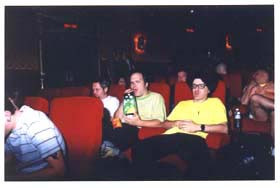
François Miron and Rick Trembles ® (Photograph provided by Jesse Gryn [email protected] )
I have not mentioned what was, for this viewer, the highlight of Fantasia 2001: the appearance of José Mojica Marins, accompanied by Brazilian film scholar André Barcinski. As if seeing brand new 35mm prints of Awakening of the Beast and This Night I’ll Possess your Corpse was not enough, spending time with the ever courteous and affable Mr. Marins and Barcinski was a real joy. Shortly after they arrived in Montreal we found out that Mr. Marins was in some discomfort because of dental surgery he had a few days prior to leaving. But he never let anything show and was a real trooper, energetically introducing both screenings and staying for enthusiastic Q & A sessions, hanging out in the lobby mingling with fans, signing autographs, posing for photographs, and seeming to genuinely have a great time. Offscreen was fortunate enough to interview Mr. Marins for nearly two hours. We knew we were in for something special when we asked our first question and Marins spoke non-stop for 20 minutes! The interview is full of amazing background information on Marins the man and his work. Stay tuned for the full transcription of the interview on Offscreen sometime in October/early November.
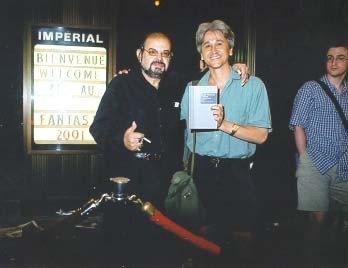
Author with “the Man” Outside Imperial Theatre (Photograph provided by Jesse Gryn [email protected] )
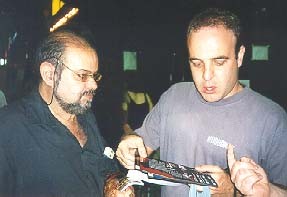
Marins (Coffin Joe) with André Barcinski Outside Imperial Theatre
For more Fantasia 2001 coverage click here: (Fantasia 2001: Post 9/11) and (Fantasia 2001: Mid-Report)



